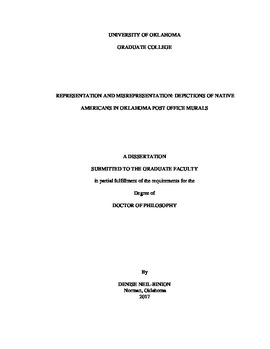| dc.description.abstract | This dissertation addresses the depictions of Native Americans in public works of art. More specifically, I am concerned with murals that were commissioned by the Section of Painting and Sculpture (the Section); a program that was administered by the United States Treasury as part of President Franklin D. Roosevelt’s New Deal Era programs (1933-1943). These paintings were installed in post offices across the country, and they were generally well received by local community members. The Section embraced the art movement of Regionalism, which led artists to paint scenes of local history, culture, and industry. Interestingly, depictions of Indigenous cultures can be found in one-quarter of the more than 1600 works of art created for the program. These images were rarely based on realistic representations, but, instead, artists often relied on stereotypes of Indigenous people. The myth of the vanishing race was commonplace as was the romanticized view of the noble savage, and some artists painted views of the Indians as savages attacking white settlers. As the longest running, government- sponsored art program, it is not possible to discuss these representations in their entirety. Instead, I will use murals painted for Oklahoma post offices as a case study for my discussion of Native themes in these New Deal era paintings. The Oklahoma post office murals include the stereotypes so frequently associated with depictions of the American Indian. However, what truly sets Oklahoma apart is that Native American artists were awarded commissions as part of this art program. Therefore, my work provides an opportunity to compare depictions of the Indigenous people of Oklahoma by both Native American and non-Native artists. To understand the reception of these paintings, I rely on the theories of E.H. Gombrich and Hans Robert Jauss as well as the writings on history and memory by Pierre Nora. By using their methodologies to frame my analysis of these paintings, I call attention to the positive reception of the depictions of Indigenous cultures based on the viewer’s own perceptions of Native American history and culture. Finally, I consider the understanding of these paintings in the twenty-first century. Some of the images painted for the Section are disrespectful to the Indigenous people they depict. Appropriation and misrepresentation are issues that must be addressed. However, censorship of art can be dangerous. In my conclusion, I argue that these representations should be properly contextualized in order to teach the public about the long-standing tropes that developed in American art through the inaccurate yet widely accepted depictions of Indigenous people of the United States. | en_US |
